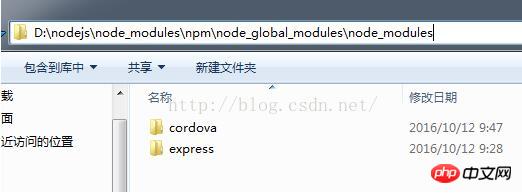
This time I will give you a detailed explanation of the steps to modify the built-in configuration path of Nodejs. What are the precautions for modifying the built-in configuration path of Nodejs? The following is a practical case, let's take a look.
The built-in npm of Nodejs will install the module by default in the user AppData directory of the c drive (complain: I don’t understand why current software likes to install resources here)

C drive is so small, it will definitely not work. Let’s modify it step by step to D drive
1. Open the cmd command line and check Current configuration
Enter npm config ls
First look at the current npm configuration environment. Since I have modified it, I can see the modified path

2. Modify the path
You need to modify two paths here, modulepath and cache path
module corresponds to prefix
cache corresponds to cache
First create two directories on other disks
D:\nodejs\node_modules\npm\node_global_modules D:\nodejs\node_modules\npm\node_cache
Then execute them in sequence
npm config set prefix"D:\nodejs\node_modules\npm\node_global_modules" npm config set cache"D:\nodejs\node_modules\npm\node_cache"
3. Modify the environment Variables
Newly added Environment variable NODE_HOME

Modify Path and add %NODE_HOME%\;%NODE_HOME%\node_modules;%NODE_HOME%\node_modules\npm\node_global_modules\;
4. Test it
Reopen a cmd command line and try to install a plug-in
Execute
npm install cordova -g// -g means to install it globally Directory
After the installation is completed, open the set installation path to see if it is successful

I believe you have mastered the method after reading the case in this article. Please come for more exciting information. Pay attention to other related articles on php Chinese website!
Recommended reading:
Detailed explanation of how to use the jQuery class name selector (.class)
vue introduces small js numbers Detailed explanation of keyboard steps
The above is the detailed content of Detailed explanation of the steps to modify the built-in configuration path of Nodejs. For more information, please follow other related articles on the PHP Chinese website!




